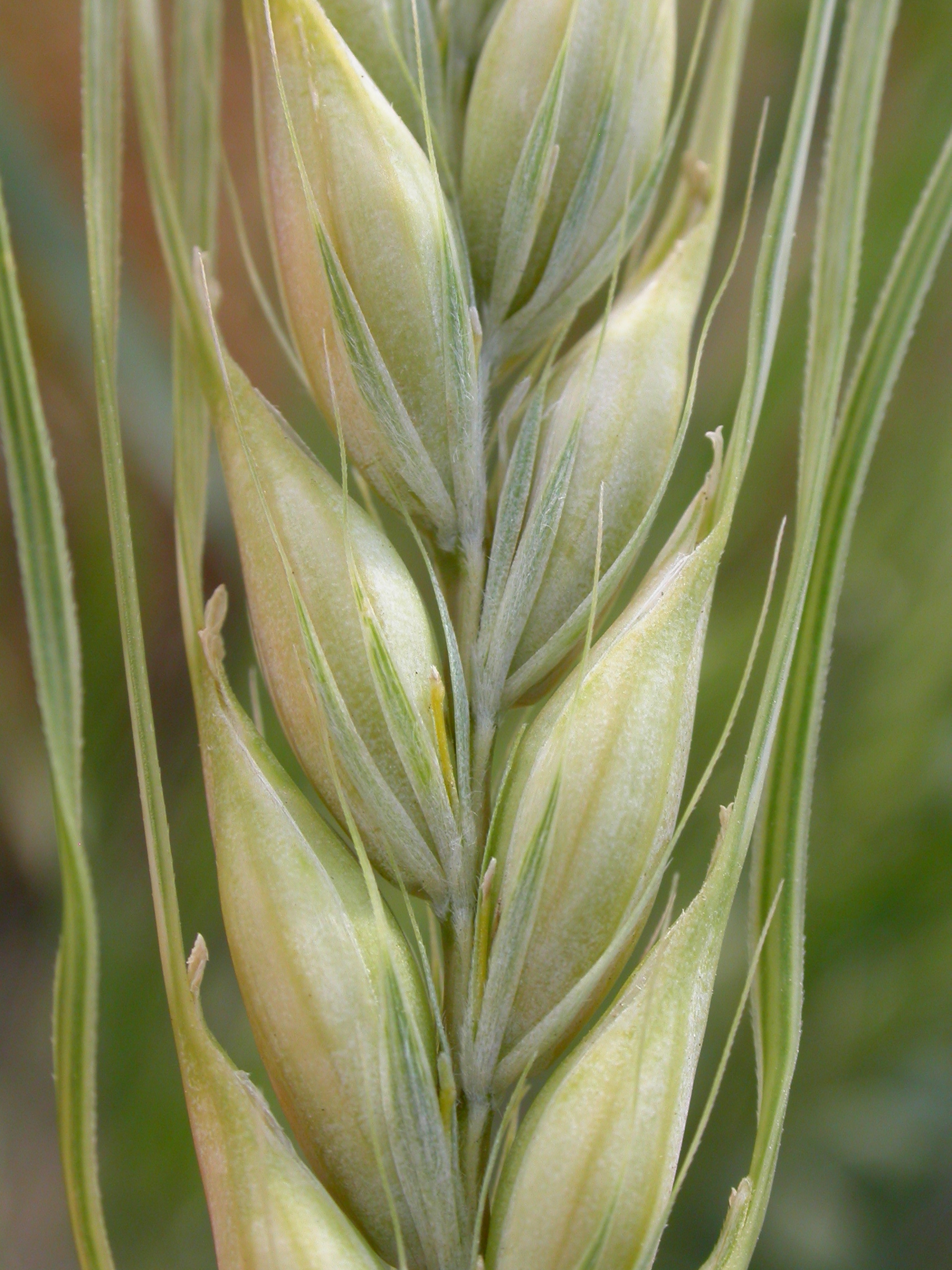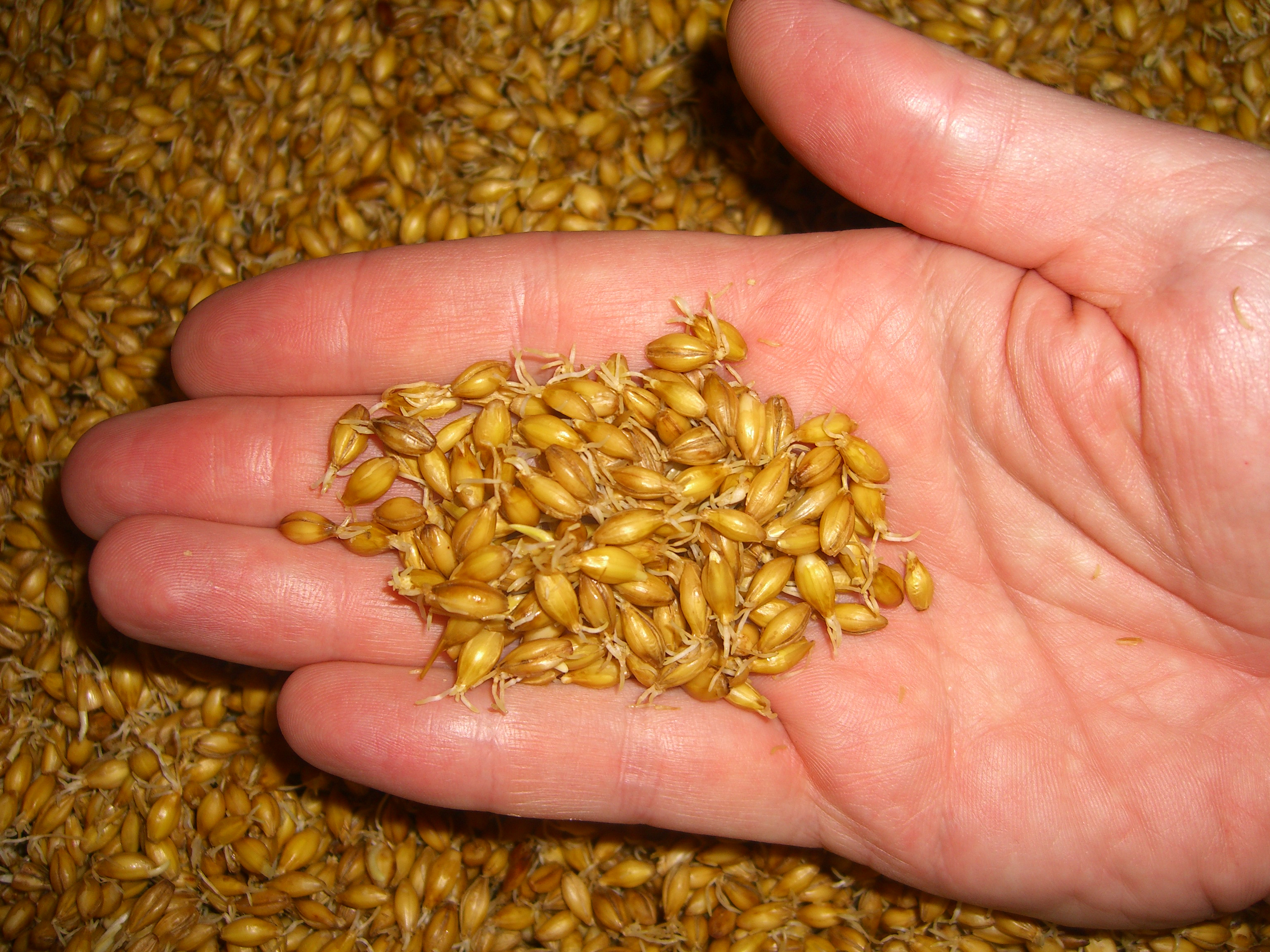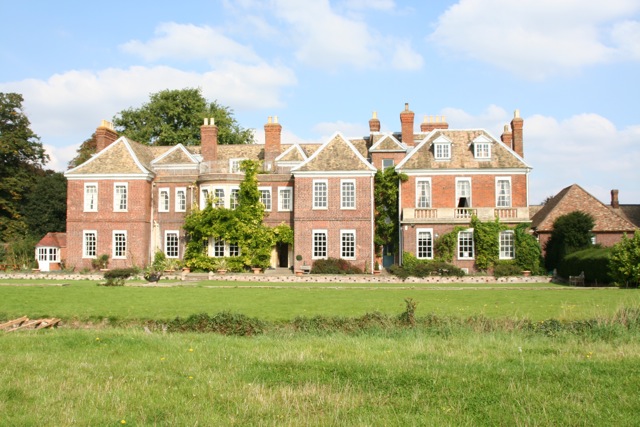|
Maris Otter
Maris Otter is a two-row, autumn sown variety of barley commonly used in the production of malt for the brewing industry. The variety was bred by Dr G D H Bell and his team of plant breeders at the UK's Plant Breeding Institute; the "Maris" part of the name comes from Maris Lane near the institute's home in Trumpington. It was introduced in 1966 and quickly became a dominant variety in the 1970s due to its low nitrogen and superior malting characteristics. By the late-1980s the variety had become unpopular with large breweries and it was removed from the UK National List in 1989. Maris Otter is a cross of Proctor and Pioneer varieties. In the 1980s Maris Otter usage began to decline for a number of reasons, including: compromised genetic purity caused by cross pollination and improved competition from other varieties. In 1992, the consortium of grain merchants H Banham Ltd & Robin Appel Ltd bought the sole right to market Maris Otter and in 2002 they bought all rights outrig ... [...More Info...] [...Related Items...] OR: [Wikipedia] [Google] [Baidu] |
Two-row Barley
Barley (''Hordeum vulgare''), a member of the grass family, is a major cereal grain grown in temperate climates globally. It was one of the first cultivated grains, particularly in Eurasia as early as 10,000 years ago. Globally 70% of barley production is used as animal fodder, while 30% as a source of fermentable material for beer and certain distilled beverages, and as a component of various foods. It is used in soups and stews, and in barley bread of various cultures. Barley grains are commonly made into malt in a traditional and ancient method of preparation. In 2017, barley was ranked fourth among grains in quantity produced () behind maize, rice and wheat. Etymology The Old English word for barley was ', which traces back to Proto-Indo-European and is cognate to the Latin word ' "flour" (''see corresponding entries''). The direct ancestor of modern English ''barley'' in Old English was the derived adjective ''bærlic'', meaning "of barley". The first citation of the f ... [...More Info...] [...Related Items...] OR: [Wikipedia] [Google] [Baidu] |
Two Row
Barley (''Hordeum vulgare''), a member of the grass family, is a major cereal grain grown in temperate climates globally. It was one of the first cultivated grains, particularly in Eurasia as early as 10,000 years ago. Globally 70% of barley production is used as animal fodder, while 30% as a source of fermentable material for beer and certain distilled beverages, and as a component of various foods. It is used in soups and stews, and in barley bread of various cultures. Barley grains are commonly made into malt in a traditional and ancient method of preparation. In 2017, barley was ranked fourth among grains in quantity produced () behind maize, rice and wheat. Etymology The Old English word for barley was ', which traces back to Proto-Indo-European and is cognate to the Latin word ' "flour" (''see corresponding entries''). The direct ancestor of modern English ''barley'' in Old English was the derived adjective ''bærlic'', meaning "of barley". The first citation of the f ... [...More Info...] [...Related Items...] OR: [Wikipedia] [Google] [Baidu] |
Winter Cereal
Winter cereals, also called winter grains, fall cereals, fall grains, or autumn-sown grains, are biennial cereal crops sown in the autumn. They germinate before winter comes, may partially grow during mild winters or simply persevere under a sufficiently thick snow cover to continue their life cycle in spring. They are harvested earlier than grains of the same type sown in springtime. In general, winter cereals have a much higher yield than spring cereals because they can use snow as moisture for growth. Winter strains are available for rye (winter or fall rye), wheat ( winter or fall wheat), barley (winter or fall barley) and triticale (winter triticale). See also * Rabi crop Rabi crops or rabi harvest, also known as winter crops, are agricultural crops that are sown in winter and harvested in the spring in India, Pakistan and Bangladesh. The complimentary of the rabi crop is the kharif crop, which is grown after t ... References Cereals Plant development {{ ... [...More Info...] [...Related Items...] OR: [Wikipedia] [Google] [Baidu] |
Barley
Barley (''Hordeum vulgare''), a member of the grass family, is a major cereal grain grown in temperate climates globally. It was one of the first cultivated grains, particularly in Eurasia as early as 10,000 years ago. Globally 70% of barley production is used as animal fodder, while 30% as a source of fermentable material for beer and certain distilled beverages, and as a component of various foods. It is used in soups and stews, and in barley bread of various cultures. Barley grains are commonly made into malt in a traditional and ancient method of preparation. In 2017, barley was ranked fourth among grains in quantity produced () behind maize, rice and wheat. Etymology The Old English word for barley was ', which traces back to Proto-Indo-European and is cognate to the Latin word ' "flour" (''see corresponding entries''). The direct ancestor of modern English ''barley'' in Old English was the derived adjective ''bærlic'', meaning "of barley". The first citation ... [...More Info...] [...Related Items...] OR: [Wikipedia] [Google] [Baidu] |
Malt
Malt is germinated cereal grain that has been dried in a process known as " malting". The grain is made to germinate by soaking in water and is then halted from germinating further by drying with hot air. Malted grain is used to make beer, whisky, malted milk, malt vinegar, confections such as Maltesers and Whoppers, flavored drinks such as Horlicks, Ovaltine, and Milo, and some baked goods, such as malt loaf, bagels, and Rich Tea biscuits. Malted grain that has been ground into a coarse meal is known as "sweet meal". Malting grain develops the enzymes (α-amylase, β-amylase) required for modifying the grains' starches into various types of sugar, including monosaccharide glucose, disaccharide maltose, trisaccharide maltotriose, and higher sugars called maltodextrines. It also develops other enzymes, such as proteases, that break down the proteins in the grain into forms that can be used by yeast. The point at which the malting process is stopped affects th ... [...More Info...] [...Related Items...] OR: [Wikipedia] [Google] [Baidu] |
Brewing
Brewing is the production of beer by steeping a starch source (commonly cereal grains, the most popular of which is barley) in water and fermenting the resulting sweet liquid with yeast. It may be done in a brewery by a commercial brewer, at home by a homebrewer, or communally. Brewing has taken place since around the 6th millennium BC, and archaeological evidence suggests that emerging civilizations, including ancient Egypt and Mesopotamia, brewed beer. Since the nineteenth century the brewing industry has been part of most western economies. The basic ingredients of beer are water and a fermentable starch source such as malted barley. Most beer is fermented with a brewer's yeast and flavoured with hops. Less widely used starch sources include millet, sorghum and cassava. Secondary sources (adjuncts), such as maize (corn), rice, or sugar, may also be used, sometimes to reduce cost, or to add a feature, such as adding wheat to aid in retaining the foamy head of the beer. ... [...More Info...] [...Related Items...] OR: [Wikipedia] [Google] [Baidu] |
George Douglas Hutton Bell
George Douglas Hutton Bell CBE FRS (18 October 1905 – 27 June 1993) was an English plant breeder who was director of the Plant Breeding Institute from 1947 to 1971. He bred Proctor, the first winter barley variety in the UK, and Maris Otter, still favoured by contemporary real ale brewers. He was appointed CBE in the 1965 New Year Honours, and awarded the first Mullard Award The Mullard Award is awarded annually by the Royal Society to a person who has "an outstanding academic record in any field of natural science Natural science is one of the branches of science concerned with the description, understanding a ... in 1967 "for the contribution the Proctor barley bred by him had made to agricultural production in the United Kingdom". References 1993 deaths 1905 births Commanders of the Order of the British Empire English scientists Fellows of the Royal Society {{England-scientist-stub ... [...More Info...] [...Related Items...] OR: [Wikipedia] [Google] [Baidu] |
Plant Breeding Institute
The Plant Breeding Institute was an agricultural research organisation in Cambridge in the United Kingdom between 1912 and 1987. Founding The institute was established in 1912 as part of the School of Agriculture at the University of Cambridge. Rowland Biffen was the first director, and was close with William Bateson who was leading studies of heredity in Cambridge following the rediscovery of the pioneering genetic research of Gregor Mendel in 1900. Biffen began studying cereal breeding in the early 1900s with the aim of producing improved varieties for farmers and millers, and also to test whether Mendel's laws applied to wheat. He demonstrated that resistance to yellow rust was a dominant trait and this culminated in 1910 in the release of the rust-resistant variety Little Joss, which was widely grown for decades and used as a parent for many other varieties. The institute's site was to the west of Cambridge, and it shared land with the School of Agriculture that is today the ... [...More Info...] [...Related Items...] OR: [Wikipedia] [Google] [Baidu] |
Trumpington
Trumpington is a village and parish to the south of Cambridge, England. The village is an electoral ward of the City of Cambridge and a ward of South Cambridgeshire District Council. The 2011 Census recorded the ward's population as 8,034. The village was a separate parish from the Anglo-Saxon era until the 20th century. In 1912 all of the land north of Long Road was transferred to Cambridge, and in 1934 most of the remaining land, including all of the village, was also given over to Cambridge. Only , almost uninhabited, were transferred to Haslingfield parish. The Cambridge Local Plan 2006 took land around the village out of the green belt and paved the way for an urban extension due for completion in 2023. A map of the enlarge village is available in ''The Trumpet'', a community magazine produced by the parish church. Archaeology There is evidence of Iron Age and Roman settlements in Trumpington, near the River Cam ford by the road to Grantchester, and a Roman cemetery. A ... [...More Info...] [...Related Items...] OR: [Wikipedia] [Google] [Baidu] |
Heirloom Plant
An heirloom plant, heirloom variety, heritage fruit (Australia and New Zealand), or heirloom vegetable (especially in Ireland and the UK) is an old cultivar of a plant used for food that is grown and maintained by gardeners and farmers, particularly in isolated or ethnic minority communities of the Western world. These were commonly grown during earlier periods in human history, but are not used in modern large-scale agriculture. In some parts of the world, it is illegal to sell seeds of cultivars that are not listed as approved for sale. The Henry Doubleday Research Association, now known as Garden Organic Garden Organic, formerly known as the Henry Doubleday Research Association (HDRA), is a UK organic growing charity dedicated to researching and promoting organic gardening, farming and food. The charity maintains the Heritage Seed Library to pre ..., responded to this legislation by setting up the Heritage Seed Library to preserve seeds of as many of the older cultivars as ... [...More Info...] [...Related Items...] OR: [Wikipedia] [Google] [Baidu] |
Registered Trademark
The registered trademark symbol, , is a typographic symbol that provides notice that the preceding word or symbol is a trademark or service mark that has been registered with a national trademark office. A trademark is a symbol, word, or words legally registered or established by use as representing a company, product or service.For example, Unregistered trademarks can instead be marked with the trademark symbol, , while unregistered service marks are marked with the service mark symbol, . The proper manner to display these symbols is immediately following the mark; the symbol is commonly in superscript style, but that is not legally required. In many jurisdictions, only registered trademarks confer easily defended legal rights. In the US, the registered trademark symbol was originally introduced in the Trademark Act of 1946. Because the symbol is not commonly available on typewriters (or ASCII), it was common to approximate it with the characters (or ). An example ... [...More Info...] [...Related Items...] OR: [Wikipedia] [Google] [Baidu] |
Agronomy
Agronomy is the science and technology of producing and using plants by agriculture for food, fuel, fiber, chemicals, recreation, or land conservation. Agronomy has come to include research of plant genetics, plant physiology, meteorology, and soil science. It is the application of a combination of sciences such as biology, chemistry, economics, ecology, earth science, and genetics. Professionals of agronomy are termed agronomists. Plant breeding This topic of agronomy involves selective breeding of plants to produce the best crops for various conditions. Plant breeding has increased crop yields and has improved the nutritional value of numerous crops, including corn, soybeans, and wheat. It has also resulted in the development of new types of plants. For example, a hybrid grain named triticale was produced by crossbreeding rye and wheat. Triticale contains more usable protein than does either rye or wheat. Agronomy has also been instrumental for fruit and vegetable produ ... [...More Info...] [...Related Items...] OR: [Wikipedia] [Google] [Baidu] |







